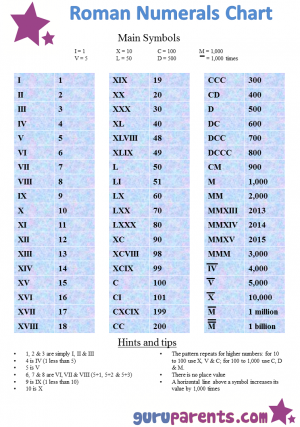Introduction
Our Roman numerals chart provides a simple introduction to the Roman numbering system, and how this system relates to our own.
Now, you may think that there is not a whole lot of value in your child learning this ancient system of writing numbers. Well, allow us to convince you!
Benefits of learning Roman numerals
1. School curriculum: Roman numerals are taught in school (in most countries), so if your child already knows them they will have a nice little headstart.
2. Addition and subtraction practice: Take for example the number 89, or, as the Romans would have written it: LXXXIX. This translates to 50 + 10 + 10 + 10 + (10 – 1). Virtually every Roman number requires some level of mental arithmetic and the more practice that your child gets at this, the better!
3. Place value: The concept of place value is an important one for children to master. The fact that Roman numerals do not have place value is interesting to explore with your child, and may help in their understanding of it.
For example, you could point out that in the number 15, “5” represents “five ones”, whereas in 51, it represents “five tens” – and compare this to how in Roman numerals, V always means “5”, no matter where it appears in the number.
4. Lack of zero (more advanced): It may surprise you, but the incorporation of zero into a numerical system was a landmark moment in mathematical history, and, as advanced as they were, it was beyond the Romans. As a result, although their number system is fine for tallying things up it is not good for addition and subtraction, let alone multiplication and division. If this is of interest to you or your child, you may enjoy this article.
5. Very large numbers (more advanced): You will see on the Roman numerals chart we have included a million and a billion right at the end. If your child is suitably advanced, discussing such enormous numbers with them can be fun and can stimuate their imagination and sense of wonder.
6. General knowledge: A basic ability to recognize and read Roman numerals is expected of a well-educated adult. Whether it is inscriptions on old buildings, on clocks, or at the end of films, Roman numerals crop up relatively often and an ability to decipher them is often regarded as a subtle hallmark of intelligence.
7. Fun: Mastering Roman numerals is a bit like learning a secret code. And, once you know how they work, every time you see one it can be a challenge to try to quickly work out what number it is. In our modern world where there is so much negativity surrounding math (and how difficult and boring it is!) any chance for your child to have fun with it should not be missed!
Final word
We think that printing and displaying our free Roman numerals chart is a great little way to boost your child’s mathematical proficiency.
However, if your child finds it boring or baffling, don’t try to force the issue – simply put it away for another day and move on to something else, such as a more traditional numbers chart like this.

